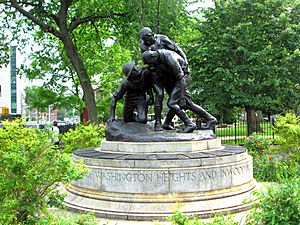Washington Heights-Inwood War Memorial facts for kids
The Washington Heights-Inwood War Memorial, also known as the Inwood Monument, is a special statue that remembers soldiers from World War I (WWI). This war happened a long time ago, from 1914 to 1918. The monument was created by a famous artist named Gertrude Vanderbilt Whitney, with its base designed by Albert Randolph Ross. You can find it in Mitchel Square Park in New York City, New York, at the corner of Broadway and Saint Nicholas Avenue.
Contents
What is the Inwood Monument?
The Inwood Monument was officially opened on Memorial Day, May 30, 1922. It honors brave men from the Washington Heights and Inwood areas of northern Manhattan who fought and died in World War I. The monument specifically remembers servicemen from three parts of the military: the Navy, the Army, and the Marine Corps.
Who was Gertrude Vanderbilt Whitney?
The artist who sculpted this monument, Gertrude Vanderbilt Whitney, was very involved in World War I. She traveled to France to help start a hospital and care for injured soldiers. Unlike many other war memorials that show war as glorious, her sculptures show the real experiences of everyday soldiers.
Whitney drew inspiration from her sketches made in France. She wanted to show soldiers as they truly were, not just heroes. Even though she was a talented artist, she was often more recognized for her wealth and for supporting other artists. This was partly because of common ideas about women artists at the time. Creating public monuments like the Inwood Monument allowed her to express her feelings about the war and her own experiences.
How was the Monument Designed?
The Inwood Monument features three figures, but it actually started as a sketch of just two soldiers. Whitney first created a sculpture called His Bunkie between 1916 and 1919. It showed one soldier standing and another kneeling.
After she was asked to create the monument, Whitney added a third figure. This new figure kneels below the first two, who are supporting their fallen friend. She also made a smaller model of the monument between 1921 and 1922. This model helped her create the final, larger statue showing the soldier, the sailor, and the marine.
The monument sits on a granite base. An important message is carved into it: "Erected by the people of Washington Heights and Inwood in commemoration of the men who gave their lives in the World War." Around the monument, there are 20 star-shaped bronze plaques. These plaques represent the 357 local men from the Manhattan area around Mitchel Square Park who died in the war. The monument's main idea is to honor the common soldier, especially those who were wounded. This makes it different from other war memorials that might focus on famous generals or the glory of war.
How was the Monument Built?
The sculpture of the three servicemen was first modeled between 1921 and 1922. Then, it was cast in bronze by a company called Roman Bronze Company in 1922. The bronze figures stand on a white marble base. On top of this base is a round granite pedestal, which holds the twenty bronze plaques. These parts were built by Alfred Randolph Ross.
The Washington Heights and Inwood Memorial Association asked Whitney to create this public monument. Her contract was signed in July 1921. It took her ten months to finish the monument. It was completed on May 26, 1922, just a few days before its dedication ceremony.
When was the Monument Dedicated?
The dedication ceremony for the Inwood Monument happened on May 30, 1922, which was Memorial Day. This date was chosen to match other parades and military events happening across New York City. Many people attended, including citizens, war veterans, and important figures like Colonel William Hayward and Mayor Hylan of New York. Members of the Washington Heights and Inwood Memorial Association, the Veterans of Foreign Wars, and various religious and political leaders were also there.
It's interesting to note that the dedication also happened on the same day that Mitchel Square Park was named in honor of Mayor John Purroy Mitchel. He had died during air service training for the Army Aviation Corps in World War I.
Restoring the Monument
The Inwood Monument was fully restored in 1998. This restoration project was paid for by donations from citizens and a grant from the U.S. World War I Centennial Commission. A big helper in getting the money was former New York City Council Member Guillermo Linares.
The project was led by Rudolph L. Leibel, a professor at Columbia University and a veteran himself. He felt a strong connection to the monument because he passed by it every day for years. The New York City Parks Department put together a team to make repairs. One important repair was making a new bayonet for the Army soldier's rifle. The original bayonet had been stolen more than once! This theft was a big reason why Professor Leibel wanted to start the restoration.
Besides the new bayonet, the restoration also included fixing the stone parts and adding a protective wax coating to all the bronze parts of the monument. More recently, on November 7, 2018, a ceremony was held in the park to celebrate both the monument's restoration and 100 years since World War I ended. Professor Leibel gave a speech at this event.


